Top Rankings
Vermillion School District 13-1 ranks among the top 20% of public school district in South Dakota for:
Category
Attribute
Graduation Rate
Highest graduation rate (Top 20%)
Diversity
Most diverse schools (Top 1%)
Community Size
Largest student body (number of students) (Top 1%)
For the 2025 school year, there is 1 public elementary school serving 332 students in Vermillion School District 13-1. This district's average elementary testing ranking is 7/10, which is in the top 50% of public elementary schools in South Dakota.
Public Elementary School in Vermillion School District 13-1 have an average math proficiency score of 47% (versus the South Dakota public elementary school average of 43%), and reading proficiency score of 61% (versus the 49% statewide average).
Minority enrollment is 25% of the student body (majority American Indian), which is less than the South Dakota public elementary school average of 36% (majority American Indian).
Overview
This School District
This State (SD)
# Schools
3 Schools
497 Schools
# Students
772 Students
101,009 Students
# Teachers
50 Teachers
7,507 Teachers
Student : Teacher Ratio
15:1
15:1
District Rank
Vermillion School District 13-1, which is ranked within the top 50% of all 146 school districts in South Dakota (based off of combined math and reading proficiency testing data) for the 2021-2022 school year.
The school district's graduation rate of 85-89% has stayed relatively flat over five school years.
Overall District Rank
#57 out of 148 school districts
(Top 50%)
(Top 50%)

Math Test Scores (% Proficient)
43%
42%
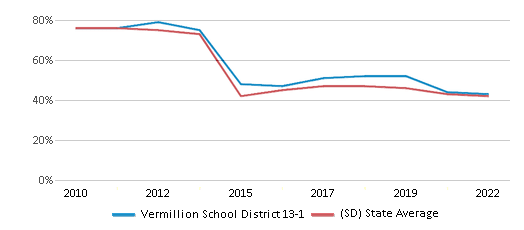
Reading/Language Arts Test Scores (% Proficient)
57%
51%
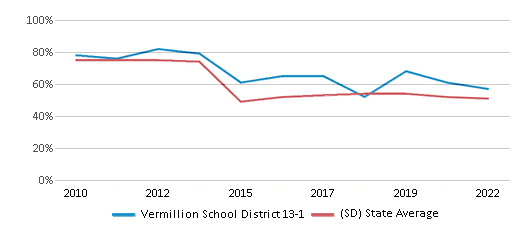
Science Test Scores (% Proficient)
43%
42%
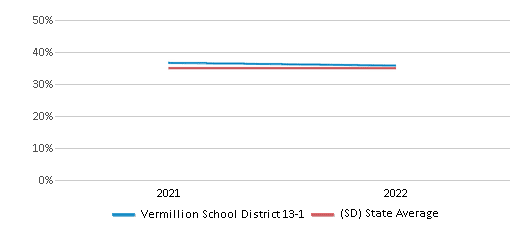
Graduation Rate
85-89%
82%
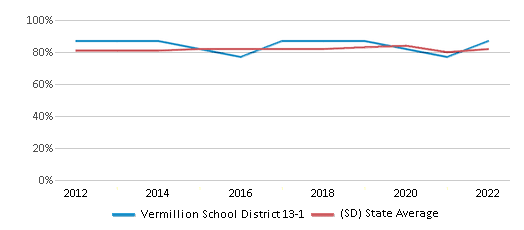
Students by Ethnicity:
Diversity Score
0.44
0.55
# American Indian Students
82 Students
16,670 Students
% American Indian Students
11%
17%
# Asian Students
12 Students
1,571 Students
% Asian Students
1%
2%
# Hispanic Students
38 Students
8,335 Students
% Hispanic Students
5%
8%
# Black Students
18 Students
3,317 Students
% Black Students
2%
3%
# White Students
568 Students
64,951 Students
% White Students
74%
64%
# Hawaiian Students
n/a
129 Students
% Hawaiian Students
n/a
n/a
# Two or more races Students
54 Students
6,036 Students
% of Two or more races Students
7%
6%
Students by Grade:
# Students in PK Grade:
-
2,878
# Students in K Grade:
-
11,668
# Students in 1st Grade:
-
10,796
# Students in 2nd Grade:
-
10,955
# Students in 3rd Grade:
-
10,445
# Students in 4th Grade:
-
10,671
# Students in 5th Grade:
-
10,790
# Students in 6th Grade:
118
10,958
# Students in 7th Grade:
118
9,781
# Students in 8th Grade:
96
9,926
# Students in 9th Grade:
113
674
# Students in 10th Grade:
121
577
# Students in 11th Grade:
98
475
# Students in 12th Grade:
108
415
# Ungraded Students:
-
-
District Revenue and Spending
The revenue/student of $20,514 is higher than the state median of $13,121. The school district revenue/student has grown by 66% over four school years.
The school district's spending/student of $19,628 is higher than the state median of $12,623. The school district spending/student has grown by 66% over four school years.
Total Revenue
$16 MM
$1,916 MM

Spending
$15 MM
$1,844 MM
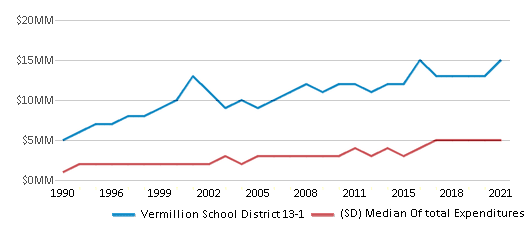
Revenue / Student
$20,514
$13,121
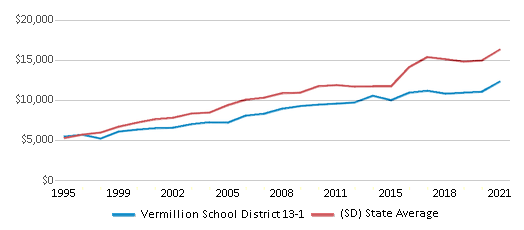
Spending / Student
$19,628
$12,623

Best Vermillion School District 13-1 Public Elementary Schools (2025)
School
(Math and Reading Proficiency)
(Math and Reading Proficiency)
Location
Grades
Students
Rank: #11.
Vermillion Middle School - 02
(Math: 47% | Reading: 61%)
Rank:
Rank:
7/
Top 50%10
422 Princeton St
Vermillion, SD 57069
(605) 677-7025
Vermillion, SD 57069
(605) 677-7025
Grades: 6-8
| 332 students
Recent Articles

Year-Round Or Traditional Schedule?
Which is more appropriate for your child? A year-round attendance schedule or traditional schedule? We look at the pros and cons.

Why You Should Encourage Your Child to Join a Sports Team
Participating in team sports has a great many benefits for children, there is no doubt. In this article you will learn what those benefits are.

White Students are Now the Minority in U.S. Public Schools
Increasing birth rates among immigrant families from Asia and Central and South America, combined with lower birth rates among white families, means that for the first time in history, public school students in the United States are majority-minority. This shift in demographics poses difficulties for schools as they work to accommodate children of varying language abilities and socio-economic backgrounds.





